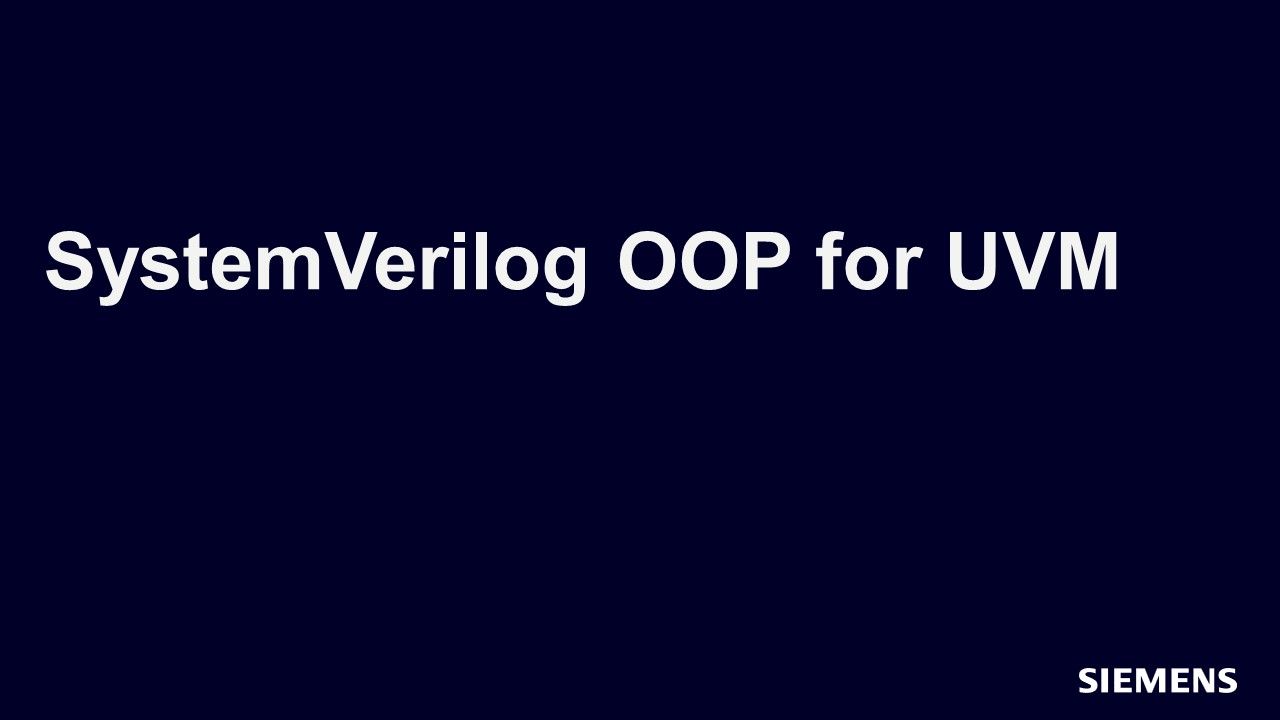SystemVerilog
SystemVerilog is a hardware description and verification language that combines elements from a number of different language technologies into a unified simulation and synthesis platform. It provides a robust set of features and constructs specifically designed for the verification of complex digital designs including object-oriented programming, assertions, functional coverage and constrained random stimulus generation. As a verification engineer, understanding and utilizing SystemVerilog can greatly enhance your ability to effectively test and verify hardware designs.
-

On-Demand
Generating SystemVerilog Assertion Properties with Property Assist
In this webinar, you will learn how Questa Property Assist automatically generates SystemVerilog Assertions (SVA) that describe the behavior of hardware designs, using AI technology. In addition, Property Assist turns user prompts into optimized LLM prompts, retrieves LLM provided solutions, and presents the best generated SVA solutions for the user.
-
SystemVerilog Tracks
-

Functional Verification of Digital Logic
Dive into the world of functional verification with our advanced master’s-level course, developed in collaboration with North Carolina State University. This comprehensive program covers all essential aspects of creating sophisticated constrained-random, coverage-driven testbenches using SystemVerilog and UVM. -

SystemVerilog OOP for UVM Verification
The SystemVerilog OOP for UVM Verification is aimed at introducing the OOP features in SystemVerilog most commonly used by the UVM in the simplest form. -

Improving Your SystemVerilog Language and UVM Methodology Skills
If you are building complex testbenches with SystemVerilog and UVM, this series is for you. The series dives into many aspects of these two areas, to give you deeper insight about how to apply the language and methodology on your projects. Whether you are new to SystemVerilog and UVM, or have been writing code for many years, take a fresh look at the fundamentals and learn some new ideas and approaches. -

An Introduction to Unit Testing with SVUnit
SVUnit is an open-source test framework for ASIC and FPGA developers writing Verilog/SystemVerilog code. SVUnit is the only SystemVerilog test framework suited for both design and verification engineers.
-
-
SystemVerilog Forum
-
Block Container - Introduction
-
SystemVerilog Introduction
At its core, SystemVerilog enables engineers to describe the behavior and structure of digital circuits. It allows for the definition of modules, which are encapsulated units of functionality that can be interconnected to create larger designs. Modules can include both structural elements, such as gates and registers, as well as behavioral elements, such as procedural blocks and tasks.
One of the key benefits of SystemVerilog is its support for constrained random testing. Verification engineers can utilize the language's built-in randomization features to generate stimuli that exercise a design's functionality in a systematic and comprehensive manner. By defining constraints on the random values, engineers can ensure that the generated test cases meet specific requirements, such as coverage goals or corner-case scenarios.
In addition to randomization, SystemVerilog offers various constructs for writing functional tests. These include assertions, which allow engineers to specify properties that the design must satisfy, and covergroups, which provide a mechanism for monitoring and collecting coverage information. Assertions help catch design bugs early by checking for specific conditions or properties during simulation, while covergroups help quantify the completeness of the test suite by measuring how much of the design has been exercised.
Another powerful feature of SystemVerilog is its support for transaction-level modeling (TLM). TLM enables engineers to model complex protocols and interconnects at a higher level of abstraction, allowing for more efficient verification of system-level designs. TLM facilitates the creation of reusable and scalable verification environments, as engineers can focus on the behavior and interactions of higher-level components without getting bogged down in the details of individual signals and registers.
SystemVerilog also provides extensive support for functional coverage, which is critical for ensuring that a design has been adequately tested. Engineers can define coverage points that represent specific design features or events and track their activation during simulation. By analyzing the coverage results, engineers can identify untested areas of the design and refine their test suite accordingly.
Furthermore, SystemVerilog includes features for testbench automation and reuse. Verification engineers can define reusable verification components, such as monitors, drivers, and scoreboards, which help automate common tasks and facilitate the integration of different verification components. This modularity and reusability improve productivity by enabling engineers to build on existing components and focus on the unique aspects of the design under test.
-
-
Block Container - Bullets
-
SystemVerilog Features
- Object-oriented programming: SystemVerilog supports object-oriented programming (OOP) concepts such as encapsulation, inheritance, and polymorphism, allowing for modular and reusable code.
- Hardware description capabilities: SystemVerilog extends the Verilog hardware description language (HDL) with new constructs for more efficient and concise hardware modeling, such as enhanced data types, structs, and unions.
- Assertions and functional coverage: SystemVerilog includes built-in constructs for writing assertions and functional coverage, enabling designers to define and verify the desired behavior of their designs more easily.
- Testbench development: SystemVerilog provides constructs for developing powerful and flexible testbenches, including the ability to create test sequences, randomization, and transaction-level modeling.
- Concurrency and parallelism: SystemVerilog supports concurrent execution of code through the use of processes, enabling designers to describe complex systems that operate in parallel.
- System-level modeling: SystemVerilog offers features for modeling system-level designs, including hierarchical design and inter-module communication using channels and interfaces.
-
SystemVerilog Benefits
- Improved productivity: SystemVerilog's high-level constructs and features enable designers to write more concise and readable code, reducing development time and effort.
- Enhanced verification capabilities: The built-in support for assertions and functional coverage helps improve the verification process by enabling designers to catch bugs and ensure functional correctness.
- Code reusability: With its object-oriented capabilities, SystemVerilog promotes code reusability and modularity, allowing designers to build upon existing components and reduce development time.
- Increased design quality: SystemVerilog's rich set of features and constructs helps designers create more robust and reliable designs, reducing the likelihood of errors and improving overall design quality.
- Seamless integration with existing Verilog designs: SystemVerilog is backward-compatible with Verilog, making it easy to integrate existing Verilog designs and leverage the benefits of SystemVerilog without starting from scratch.
- Support for industry standards: SystemVerilog is widely adopted and supported by industry-standard simulation and synthesis tools, ensuring compatibility and interoperability across different design environments.
-
-
Block Container - Conclusion
-
SystemVerilog Conclusion
In summary, SystemVerilog is an incredibly powerful language specifically designed for hardware description and verification purposes, providing a rich set of features and constructs. As a verification engineer, becoming proficient in SystemVerilog can significantly augment your capability to thoroughly test and verify intricate digital designs. Its expansive range of functionalities, including constrained random testing, assertions, transaction-level modeling (TLM), functional coverage, and testbench automation, empowers you to efficiently create comprehensive and scalable verification environments. By harnessing the full potential of SystemVerilog, you can greatly enhance the quality and reliability of hardware designs while simultaneously minimizing the time and effort required for verification.
One of the key strengths of SystemVerilog lies in its support for constrained random testing. This methodology allows you to generate stimulus for your design in a controlled yet random manner, effectively exercising various scenarios and corner cases. By systematically exploring a wide range of inputs, you can uncover potential bugs and design flaws that might otherwise go unnoticed with traditional testbenches. Moreover, SystemVerilog's assertions enable you to specify expected behaviors and design properties, facilitating early bug detection and reducing the time spent debugging.
Additionally, SystemVerilog's functional coverage capabilities assist in tracking the completeness of your test suite, ensuring that all important design aspects have been thoroughly exercised and verified.
Testbench automation is another area where SystemVerilog excels. With its rich set of constructs and methodologies, you can build reusable and modular testbenches that streamline the verification process. SystemVerilog's object-oriented programming (OOP) features allow you to create well-structured, maintainable testbenches that can be easily extended and adapted as your design evolves. This level of automation not only improves productivity but also enhances the overall reliability and maintainability of the verification environment.
By effectively utilizing SystemVerilog, you can achieve higher quality and reliability in your hardware designs. The language provides a comprehensive set of features and constructs that enable you to design and implement robust verification environments. By leveraging constrained random testing, assertions, TLM, functional coverage, and testbench automation, you can systematically and efficiently verify the functionality and correctness of your digital designs. This approach minimizes the risk of undetected bugs and design errors, ultimately leading to a more reliable and robust end product.
In conclusion, SystemVerilog is a powerful language that empowers verification engineers to test and verify complex digital designs effectively. Its extensive range of features and constructs, including constrained random testing, assertions, functional coverage, and testbench automation, enhances the quality and reliability of hardware designs while reducing verification time and effort. By mastering SystemVerilog, engineers can create comprehensive and scalable verification environments, ensuring the correctness and robustness of their designs.
-